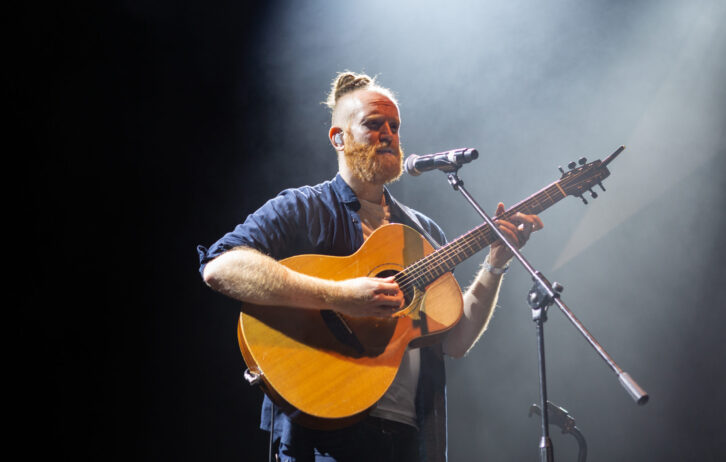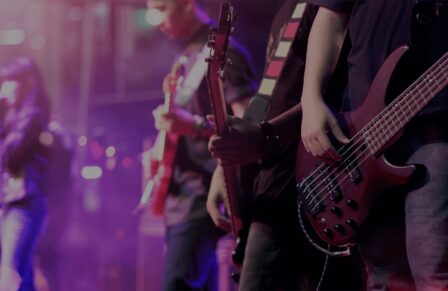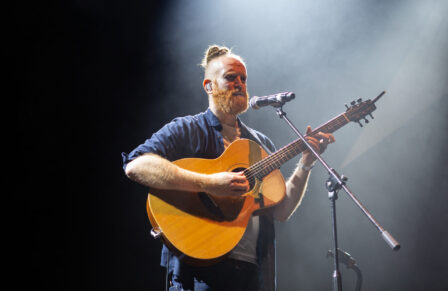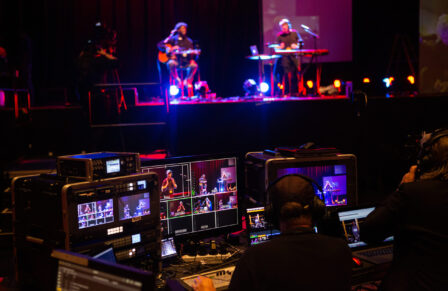5G Festival: case study
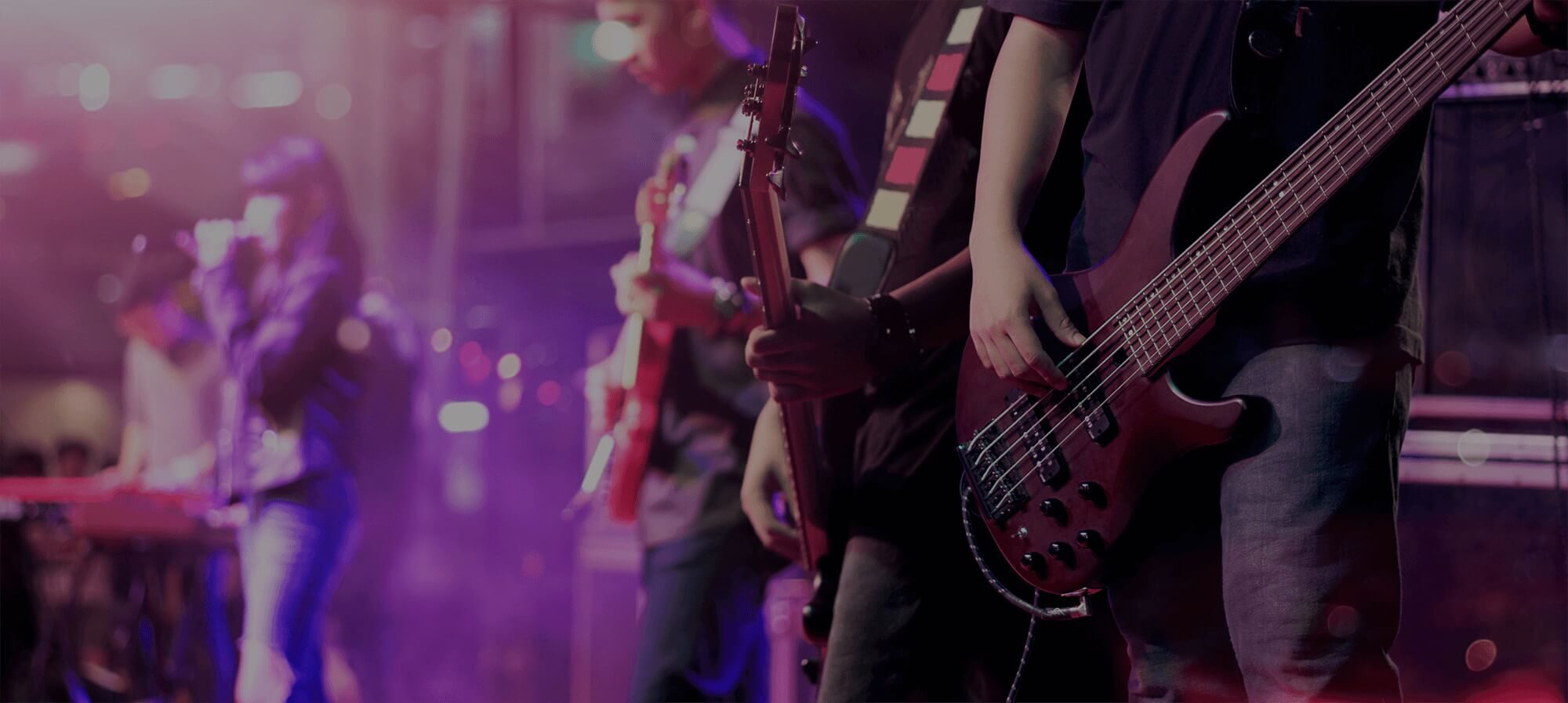
5G Festival becomes the world’s first live immersive hybrid concert, creating an exciting new business model for music professionals, live venues and artists.
Digital Catapult and its partners staged the world’s first 5G-powered hybrid immersive festival.
At the 5G Festival, 21 artists performed together across three UK venues: the Brighton Dome, the O2 Blueroom at The O2 and Metropolis Studios in London, to show how 5G and immersive technologies can seamlessly connect artists and audiences in real time, anywhere in the world.
The 5G Festival is the successful culmination of a £5 million, two-year technology collaboration led by Digital Catapult and its partners:
- Audiotonix: audio mixing consoles, immersive in-ear monitoring and AoIP networking
- Brighton Dome & Brighton Festival: renowned live arts venue and cultural organisation working with Brighton 5G testbed partner Wired Sussex
- LiveFrom: blockchain ticketing
- Mativision: 5G, 360° immersive live streaming and distribution platform
- Metropolis Studios: audio mixing, production and music venue
- Sonosphere: immersive audio and live streaming
- Virgin Media O2: telecommunications service provider and sponsor of The O2 and O2 Academy venues
- Warner Music Group: global music company
“Music is at the heart of the O2 brand. We’re always looking at ways in which we could enhance the live music experience, from the moment a ticket is purchased all the way through to the event. The 5G Festival was a perfect fit for O2 – it looked at technology, how we could enhance music events and was focused on our venues as well.”
David Owens, Head of Technical Trials at Virgin Media O2
The 5G Festival, took place across three prestigious UK music venues:
- Brighton Dome: the leading arts and entertainment venue in the South East, with three distinct performance spaces including its 1,800-seat Concert Hall
- O2 Blueroom at The O2: an intimate live music space, lounge and bar inside The O2, the world’s top arena for ticket sales since 2008, with a capacity of 20,000
- Metropolis Studios: Europe’s number one independent recording studio, home to the best mastering engineers in the world
This pioneering live event was delivered using the latest advances in 5G (Stand-alone, Mobile Edge Compute) and immersive technology (virtual and augmented reality). The core 5G infrastructure is based on Digital Catapult’s 5G testbeds in Brighton and London, linked with Virgin Media O2’s public 5G network.
The 5G Festival project aims to create a more diverse, sustainable live music industry and reach new audiences anywhere in the world. 5G technology and its ability to transmit with low latency (delay) and ultra-high bandwidth, can allow separate music professionals to produce, collaborate and perform in real time, without restrictions on travel, location and availability.
“It sounds crazy now, but when we started the project, none of us were actually sure we could really do it. We had all sorts of doubts about whether we really could collaborate remotely like this with parties playing together across all the different stages, but everyone proved it could be done.”
Neil Hooper – Group Chief Technology Officer, Audiotonix
Discovering new opportunities for artists and music professionals to collaborate and produce music, while transforming the live audience experience
“We felt that 5G was a really rich area to explore. It was something that fitted with our vision and mission as an organisation wanting to explore new technology for artists and audiences that would place us at the cutting edge”
Andrew Comben – Chief Executive, Brighton Dome & Brighton Festival.
The idea for a 5G powered festival was conceived long before COVID-19 devastated the live music industry, when teams from Digital Catapult and the Brighton Dome & Brighton Festival came together to discuss how 5G technology could improve the live venue experience.
At that time, Mativision, a live event and immersive content company, had started to explore new ways for musicians to produce music using virtual and augmented reality.
Anthony Karydis, founder and CEO of Mativision, understood the difficulties artists face in trying to create music while separated by distance. Instead of working together, musicians often produce their parts in isolation before sending their work to a mixing studio.
“This was a very asynchronous way of producing music,” Anthony Karydis explained. “How could it be possible to bring all these people together and allow them to create music in a synchronous way, even though they are separated from each other?”
5G Festival develops a commercial business model for music professionals, live venues and artists
5G Festival was announced as part of the first wave of 5G Create projects in July 2020. The project objective was to design, build and demonstrate a 5G enabled, immersive, virtual music platform that could improve artists’ ability to produce and collaborate remotely, transform the in-venue audience experience and create new forms of hybrid and live festival events.
Three use cases were developed for the project:
- Remote music production – Two or more artists in remote locations would be able to play synchronously via a 5G network, see each other for visual cues using augmented reality and experience audience reactions in virtual reality.
- Virtual Festival (at home) – Audiences at home consume a combined live feed from collaborating artists using any device for a rich, immersive, live music experience without the need for travel.
- Hybrid Festival (at venue) – Audiences at a physical venue experience part of a live hybrid collaborative performance, using immersive technology to augment the traditional experience.
As well as the challenges in connecting three venues in a 5G network loop, for audio professionals, the first hurdle was latency, the delay in the time it takes for sound to travel from its source to a listener’s ears. Starting in March 2021, Sonosphere – experts in immersive audio and live streaming – led a series of trials to focus on the technical and audio production. Along with teams from Audiotonix and Mativision, the three technology partners ironed out any audio and video barriers, adapting 5G connectivity to sync artists across three locations.
Trial 1 – In the Brighton Dome, artists were physically separated from one another in the same venue, but performed together live, to examine the effects of audio latency on their ability to play in sync. By dialling the delay up and down, audio professionals tested how artists could cope with latency and the limits they could tolerate before it compromised their performance. The impact of immersive in ear mixes were also tested. This showed that artists were more tolerant to latency with an immersive mix over a simple stereo mix.
Trial 2 – The second trial examined the limitations of audio latency for a group of musicians playing together across two separate locations, using spatial audio (instead of stereo) to support the collaboration. For this trial, musical director Kojo Samuel created a group called The Remotes – formed of a vocalist, bass player, lead guitarist and keyboard player, splitting these between separate areas in the Brighton Dome, as they performed in sync with a vocalist and drummer in Metropolis Studios.
Trial 3 – In preparation for the live showcase, the third trial focused on the remaining technical issues with audio and video latency, using experienced session musicians playing in Brighton Dome’s Concert Hall and Band Room and 60 miles away in Metropolis Studios. For the first time, these artists appeared in front of a live audience, invited to the trial to offer feedback ahead of the live 5G Festival.
Metropolis Studios facilitated production for the trials, the final showcase and the centralised immersive audio hub for the 5G Festival project – with the Sonosphere team collecting audio feeds from Brighton Dome and the O2 Blueroom, in its Dolby Atmos 3D Studio at Metropolis Studios before sending these back to the artists and audiences in different immersive formats.
Adapting immersive technology and 5G connectivity
“During the first trials, we realised that even though the network was at a very early stage, we were getting an eight millisecond round trip, which is like standing eight feet away from somebody and talking. At that point, we all knew that we could do it.”
Jamie Gosney – Director & Owner, Sonosphere
As the global market leader in professional audio and AoIP solutions, Audiotonix enlisted teams from its specialised brands to facilitate the audio networking, including:
- Calrec: designer and supplier of broadcast audio mixing consoles. Calrec provided the expertise to set up the AoIP network, which carried both the audio and the video between the three venues.
- DiGiCo: digital audio mixing consoles and systems for live sound events.
- KLANG:technologies: immersive and personal in-ear monitoring.
During the trials and final showcase, KLANG played a crucial role in connecting performers across the three live venues. With KLANG, each artist could produce their own surround mix and position the sound of their fellow musicians in a 360-degree field to feel fully immersed in the performance.
“The 5G Festival offered us the opportunity to significantly enhance the live music experience, support artists’ creativity, expand our technical knowledge further and work with other world class UK companies in the entertainment industry. ”
Neil Hooper – Group Chief Technology Officer, Audiotonix
At the core of the project, Mativision developed a 5G, 360-degree immersive live streaming and distribution platform that enabled the artists to collaborate in real time.
To connect the artists, each performer had a smartphone in front of them to capture their image. The Mativision platform received and processed the audio and video input from each artist, keeping the synchronisation intact and redistributed these to the artists within a 360 environment where they could view and interact with one another.
The same platform distributed the immersive experience for remote audiences to watch using VR headsets or as a live video image on other devices, such as laptops, tablets or smartphones – enhanced by motion sensors.
“When we started the project, nothing in the technologies we needed actually worked. And the project was very high in risk – in the sense that we knew we had to jump a lot of hurdles, to even demonstrate that the project could deliver something. We were very aware that the project was not an easy one.”
Anthony Karydis – Founder and CEO, Mativision
For Mativision, developing the technology to help artists view each other proved to be a challenge. As VR glasses would be too cumbersome on stage, Mativision sourced prototype AR glasses. Complete with gaze control functionality, these glasses gave the artists a direct view of their environment, while over-laying the other performers as if they were in the same room. To enhance the realism, Mativision used depth sense technology, acquiring depth sensors and cameras from Intel.
“We found a company in China that was producing an AR prototype that looked like sunglasses,” explained Anthony Karydis. “We persuaded them to let us purchase three development kits, but when they arrived, we realised that they only connected by simple WiFi, which we couldn’t use, as this was a 5G project.
I’m not happy to say this, but as they say, necessity brings us to innovation, so we had to hack the devices and connect them to an Android 5G phone to get connectivity.”
5G Festival: where creativity meets technology
With the technical trials underway, it was time to focus on the creative aspects of the audience experience.
“We saw our role as the champions of the live experience and to be the bridge between the potential that 5G offers and the experience for artists and audiences,” said Andrew Comben, chief executive of Brighton Dome & Brighton Festival.
“Right from the start, this could have been an experiment, which only focused on the online consumption of music and culture.” He added. “It was really important to explore what the experience would be for the audience in the room and whether the technology could have a real and meaningful impact.”
To shape the live experience, Brighton Dome commissioned Kojo Samuel, one of the most sought after, reputable and talented musical directors in the UK. Kojo has more than a decade of experience and produces live shows across the globe for artists ranging from new musicians to chart-topping acts and Glastonbury headliners.
As Kojo shaped the live concert performance, with artists performing across three venues, it was important to create a live festival experience and explore how musicians, who wouldn’t ordinarily collaborate together, could be part of the same mix.
Elevating the audio with immersive spatial sound
On the night of the festival showcase, Sonosphere delivered fully-spatial audio, experienced throughout the venues using its award-winning Soundscape Design, featuring a d&b Audiotechnik Soundscape system, with loud speakers surrounding the audience to create rich immersive audio.
For remote audiences, Sonosphere broadcast the sound in binaural 3D-stereo for headphones and used First-order Ambisonics for VR headsets – a full-sphere surround sound format that uses head-tracking technology, so the audio stays in the right position relative to what is being viewed as the listener turns their head.
“For the audiences at the Concert Hall and Founders Room at the Brighton Dome and the O2 Blueroom, we worked with our partners at d&b Audiotechnik – who deployed their Soundscape system to create the immersive, in-venue experience,” said Jamie Gosney, Director & Owner, Sonosphere. “Also, with their company SFL Group, a multidisciplinary AV provider and a d&b solutions company, supplied the physical kits for all the venues,” he added.
“All the audio came through our immersive, spatial audio studio based at Metropolis, where we used a DiGiCo Q338 mixing console to mix the incoming audio and broadcast it to all three venues and the audience watching at home. There was a lot going on; we had more than 200 channels of audio in total.”
Challenges before the show
With the night of the festival fast approaching, the teams worked tirelessly to resolve any final technical glitches.
In the two years since the project started the scope had changed considerably. The original plan was for one artist to perform in each of the three locations, but as the trials had proved that the technology could support a greater number and enhance the festival experience, the list had now grown to 21 performers.
On the night of the event, a projection issue was spotted after the dress rehearsal. As a result, a significant part of the programme needed to be changed, as musical director Kojo Samuel reorganised the playlists 30 minutes before the festival.
Jamie Gosney, Sonosphere: “ Because there is currently no dedicated hardware for this, Audiotonix had to secure elements from its group brands, which required a team of skilled product specialists to combine their brand’s hardware and skills to deliver the end result. Ultimately we needed to set up PTP clocks (precision time protocol), across all the equipment in each of the locations so all the equipment being used for the festival was on exactly the same time to the last millisecond.”
“There was quite a lot that could go wrong in amongst all that. Even up to a week before the showcase, we’d been monitoring the network and getting glitches. Fortunately, the showcase went without any glitches at all.”
Neil Hooper, Audiotonix: “From an audio perspective, we had multiple streams from all sorts of different places, but we were confident that we could make it all seamlessly come together in the various venues on the night. We’d never done any 5G transmission work at all before this project but, in fact, we managed to transmit audio using multicast on 5G over the air, which had not been done before”
In a world-first, 21 artists performed together across multiple venues in real time, using 5G connectivity
On March 3, 2022, in a world-first hybrid concert performance, 21 artists performed together across multiple venues in real time, underpinned by 5G connectivity – showcasing the technical achievements made during the project and the expanding possibilities for music, culture and the arts.
The 5G Festival opened with singer-songwriter Newton Faulkner. At first, he was alone on stage with his guitar, with no other feed of instruments, before the live performance grew to a complete festival experience, all in sync across three separate locations.
Newton Faulker and the Brighton-based band Memorial performed at the Brighton Dome, singers Lola Young and Natalie Lindi appeared at the O2 Blueroom at The O2, while Pearl Harts and Sipprell played at Metropolis Studios.
Across the three venues, the musicians were also split, with singers, drums and a guitarist on stage at the Brighton Dome, a percussionist, bass player and singer at Metropolis Studios, along with a string quartet and guitar at the O2 Blueroom.
There were times when artists from all venues played together and moments when only one or two performed, producing a live, immersive festival, rather than a collaboration piece.
LiveFrom developed a token-based system using blockchain technology to sell online tickets for remote viewers, linked to an app developed by O2 Labs. This live experience featured an immersive 360-degree view of the artists on stage, coupled with high-definition visuals and rich spatial sound that flowed between venues and performances.
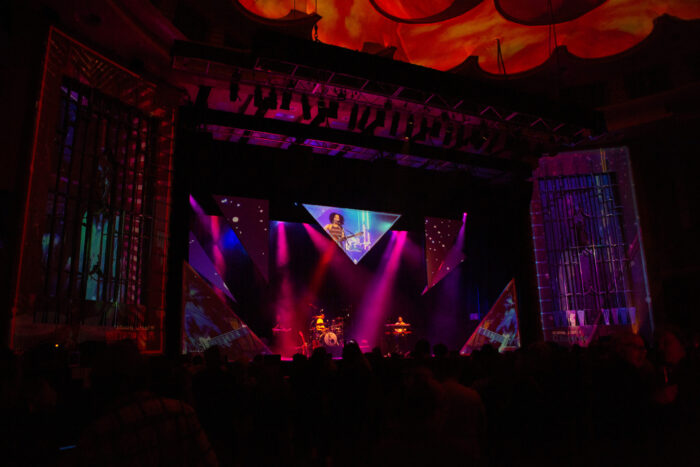
5G Festival creates opportunities for the entire music ecosystem
The 5G Festival successfully demonstrated how 5G connectivity and immersive technologies could deliver an accessible, collaborative platform for music creators, performers and audiences, without geographic limitations.
As live venues recover from the disruption of the pandemic, 5G technology can help rejuvenate the live music experience. The 5G Festival project will help to create a more diversified, sustainable live music industry, increase the opportunities to reach new audiences and offer commercial opportunities for a wide range of stakeholders.
The 5G Festival is funded by the Department for Digital, Culture, Media and Sport (DCMS) as part of the wider £200 million 5G testbeds and trials programme (5GTT) funded by the UK Government.
Kostas Katsaros – Lead 5G Technologist, Digital Catapult: “I see a very bright future. The 5G Festival has been a blueprint of how potential future events or festivals could run, enhancing the creativity of the artists and the experience of fans by adopting technologies like 5G.”
Gavin Newman – Brand Director, Metropolis Studios: “Facilitating seamless artist collaboration is an absolute game changer in how artists will be able to work in the future and something that is a real work problem which we have started to solve, not just for the music industry but culturally right across the arts. I’m excited to see what commercial products, services and partnerships we can build around immersive virtual festivals distributed to audiences at home.”
Tiago Correia – Gaming & Next Gen Partnerships, Warner Music Group: “There’s definitely going to be a bigger pool of diverse talent that can be accessed via this technology as it lowers the geographical barriers to allow artists, songwriters, producers and musicians to collaborate in new ways. 5G can be used for music production, composition and rehearsals; it can transform anyone’s bedroom into a fully-fledged production studio, with access to other technologies and physical hardware in any professional studio regardless of its location. It will be interesting for labels to see how this technology can support the creation of diverse content and how it can be monetised in the future.”
David Owens, Head of Technical Trials at Virgin Media O2: “There are lots of different legacies from this project across different sectors, not least live entertainment. 5G networks can help reach new audiences using this technology and boost the creative process for artists. And there could be future use cases too, such as smart transport systems and remote consulting for doctors in the e-health space.”
Andrew Comben – Chief Executive, Brighton Dome & Brighton Festival: “5G offers potential for anyone, particularly young people, exploring music either on an amateur or early professional basis. With 5G we could provide greater opportunities for people who are otherwise isolated or working and living in communities that don’t have access to the experiences we offer.”
“A future ambition would be to have an international collaboration, across 5G, that would allow for those musical and cross-cultural collaborations that you could only dream of.”
Jamie Gosney – Director & Owner, Sonosphere: “This project deserves to continue. We are just scratching the surface in terms of the technology we have already developed, but that will need extra funding. The extra funding would not only allow us to further develop and commercialise what we have already started, but would offer a safe investment for anyone willing to continue on this amazing journey with us.”
Anthony Karydis – Founder and CEO, Mativision: “There will be a time where people will look back on the 5G Festival, referring to this event as the first music-based event of the metaverse. A lot of people talk about the Metaverse, with legless avatars doing the work, but we had real musicians transported, not physically, but virtually to different venues. There’s nothing stopping us doing that tomorrow with any venue provided we have the simplest of 5G infrastructures, as we found out.”
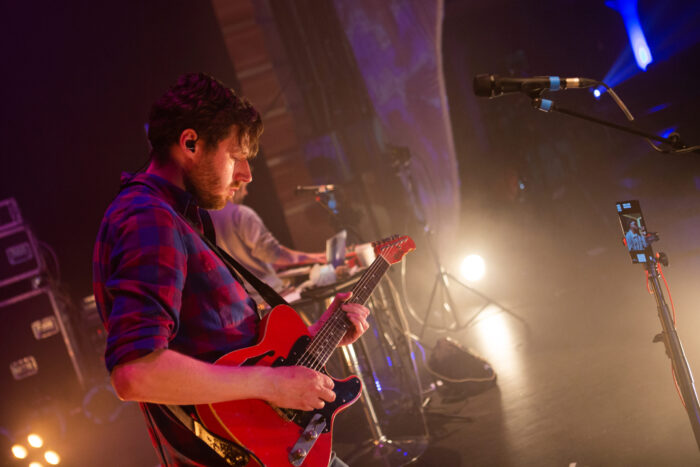
Digital Catapult newsletter
Receive case studies from across UK industry delivered directly to your inbox
Subscribe now